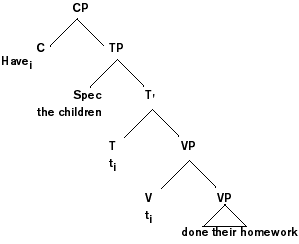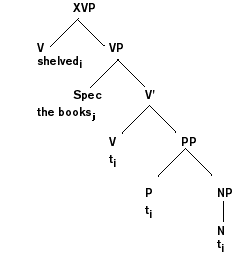
Within the syntactic framework that grew out of Chomsky (1965), elements that appear in unexpected positions are often said to have undergone movement. One case of this is wh-movement where a maximal projection (see X-BAR THEORY) moves to Spec, CP. Heads of maximal projections may also be displaced as seen by the following triple. "The children will not have done their homework." "The children have not done their homework." "Have the children done their homework?" The verb have appears in three different positions with respect to negation not and the subject the children. A head movement account assumes that have originates in V (head of VP), moves to T(ense) (head of TP), and then to C (head of CP) .

By positing a process by which heads may be moved, languages that appear to have quite different surface realizations may be seen as having similar abstract underlying representations that are then disrupted by language- specific rules of head movement. For instance, if one assumes that VPs containing the V and the object are universal (see LINGUISTIC UNIVERSALS), one can account for VSO languages (see TYPOLOGY) by positing obligatory movement of the V to a head higher in the syntactic tree in these languages.

The word order in verb second languages such as German is characterized by obligatory movement of a topic to Spec, CP and head movement of the verb to C (see PARAMETER-SETTING APPROACHES TO ACQUISITION, CREOLIZATION, AND DIACHRONY).
Another use of head movement has been to explain the tight correlation between morpheme orders and phrase structure (the mirror principle of Baker 1985) through local iterative head movement. Although the movement in English discussed earlier transposes words by moving a word into an empty head position, head movement may also move a stem into a head which contains an affix (or force movement of a word which contains this affix in MINIMALISM). For example, in Japanese where the morpheme order is V-Tense-C as in tabe-ta-to, "eat-pst-Comp(that)," the verb has undergone the same movement that we saw for English from V to T to C, picking up the head-related MORPHOLOGY.
This use of head movement to create morphologically complex words can be further extended to account for processes such as noun incorporation where the noun head of the object NP incorporates into the verb through head movement to form complex verbs like the Mohawk form in (3) (see POLYSYNTHETIC LANGUAGES as well as Baker 1988 and 1996) .
Head movement as a mechanism to build complex words interacts in obvious ways with questions concerning morphology and the LEXICON (see, e.g., diSciullo and Williams 1988 for arguments against this account of incorporation).
As well as creating morphologically complex words, head movement has been used to represent words that are morphologically simple but semantically complex. Hale and Keyser (1993) have suggested that denominal and deadjectival verbs such as shelve and thin are formed through head movement. "The children shelved the books" would be derived from a structure similar to "The children put the books on the shelf." The verb and the preposition would be null, however, allowing the movement of shelve as the head of the prepositional object NP to move iteratively through the empty P to the empty V. (The structure below contains an extra VP; see Hale and Keyser 1993 for details.)

Like other movements, head movement in not unconstrained but must obey a locality condition. Descriptively this locality condition requires movement to the most local possible landing site (the Head Movement Constraint of Travis 1984). Baker (1988) and Rizzi (1990) have subsequently reformulated this locality condition, collapsing it with the locality condition on rules that move maximal projections. The existence of this locality condition on head movement and the similarity of this condition to the condition for movement of maximal projections strengthens the claim that head movement is one instance of a more general movement rule. Further, the fact that this locality condition shows up in noun incorporation and denominal verb formation as well as the English verb movement facts strengthens the claim that they are all part of the same phenomenon. For instance, the following strings are ungrammatical for the same reason:
In all three cases an intervening head position has been skipped (the T will, the V ohare, "wash," and the P on), violating the Head Movement Constraint.
If heads must always move to head positions, then head movement may be used as a probe to determine phrase structure. For instance, Pollock (1989) has argued that there must be (at least) two head positions between C and V due to the fact that, in French, there are two possible landing sites for the verb -- one between the subject and negation (as in the English example above) and one between negation and an adverb. This may be extended as in Cinque (forthcoming) to posit head positions between different classes of adverbs in order to account for the possible placement of the participle rimesso (marked with an X) in the following Italian sentence.
It has also been proposed that head movement cannot proceed from a lexical category (N, V, A , P) through a functional category (T, C , D(et)) back to a lexical category to explain why functional (grammatical) morphemes are not found in, say, causative structures (*make-fut-work; see Li 1990). A typology of head movement has also been proposed (Koopman 1983) that includes one type of head movement with the characteristics of NP-Movement (like passive and raising), and another with the characteristics of WH-MOVEMENT.
Head movement is different from maximal projection movement in that it can be seen to create both morphologically complex as well as (the meaning of) morphologically simple words, arguably putting it into direct competition with lexical and semantic rules. Yet because it shows parallel restrictions and typology to rules that permute maximal projections, it can be said to be part of the computational component of SYNTAX.
Baker, M. (1985). The Mirror Principle and morphosyntactic explanation. Linguistic Inquiry 16:373-415.
Baker, M. (1988). Incorporation: A Theory of Grammatical Function Changing. Chicago: University of Chicago Press.
Baker, M. (1996). The Polysynthesis Parameter. Oxford: Oxford University Press.
Chomsky, N. (1965). Aspects of the Theory of Syntax. Cambridge, MA: MIT Press.
Cinque, G. (Forthcoming). Adverbs and Functional Heads: A Cross-Linguistic Perspective. Oxford: Oxford University Press.
diSciullo, A.-M., and E. Williams. (1988). On the Definition of Word. Cambridge, MA: MIT Press.
Hale, K., and S. J. Keyser. (1993). On argument structure and the lexical expression of syntactic relations. In K. Hale and S. J. Keyser, Eds., The View from Building 20. Cambridge, MA: MIT Press, pp. 53-110.
Koopman, H. (1983). The Syntax of Verbs. Dordrecht: Foris.
Li, Y. (1990). X°-binding and verb incorporation. Linguistic Inquiry 21:399-426.
Pollock, J.-Y. (1989). Verb movement, UG, and the structure of IP. Linguistic Inquiry 20:365-424.
Rizzi, L. (1990). Relativized Minimality. Cambridge, MA: MIT Press.
Travis, L. (1984). Parameters and Effects of Word Order Variation. Ph.D. diss., Massachusetts Institute of Technology.
Belletti, A. (1990). Generalized Verb Movement: Aspects of Verb Syntax. Torino: Rosenberg and Sellier.
Borsley, R. D., M.-L. Rivero, and J. Stephens. (1996). Long head movement in Breton. In R. D. Borsley and I. Roberts, Eds., The Syntax of Celtic Languages. Cambridge: Cambridge University Press, pp. 53-74.
Lema, J., and M.-L. Rivero. (1989). Long head movement: ECP vs. HMC. In J. Carter, R.-M. Dechaine, B. Philip, and T. Sherer, Eds., NELS. Carnegie Mellon University: GLSA, pp. 333-347.
Lema, J., and M.-L. Rivero. (1991). Types of verbal movement in Old Spanish: modals, futures, and perfects. Probus 3:237-278.
Lema, J., and M.-L. Rivero. (1989). Inverted conjugations and V-second effects in Romance. In C. Laeufer and T. Morgan, Eds., Theoretical Analyses in Contemporary Romance Linguistics: Selected Papers from the Nineteenth Symposium on Romance Linguistics. London: John Benjamins, pp. 311-328.
Rivero, M.-L. (1991). Long head movement and negation: Serbo-Croation vs Slovak and Czech. The Linguistic Review 8:319-351.
Rivero, M.-L. (1994). Clause structure and V-movement in the languages of the Balkans. Natural Language and Linguistic Theory 12:63-120.
Rizzi, L., and I. Roberts. (1989). Complex inversion in French. Probus 1:1-30.
Roberts, I. (1994). Two types of head movement in Romance. In D. Lightfoot and N. Hornstein, Eds., Verb Movement. Cambridge: Cambridge University Press, pp. 207-242.
Roberts, I. (1991). Excorporation and Minimality. Linguistic Inquiry 22:209-218 .